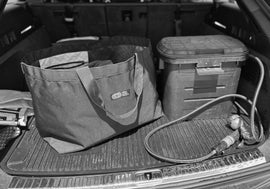Algae is a fickle thing. A certain amount is incredibly healthy for aquatic environments. It not only feeds and has symbiotic relationships with other organisms, but it also absorbs atmospheric carbon dioxide. Too much algae, though, and this protist becomes harmful, producing toxins that damage and kill ecosystems.
Sounds a little dramatic? Well just last year, toxic algae blooms killed hundreds of sea lions and dolphins off the California coast. There were reports this past January that over 5,000 tons of salmon in Chile had succumbed to their toxins. And, well, there’s a reason people aren’t allowed to swim when too much algae is present—it’s just not safe.

Fortunately, one company has found a way to turn harmful algae blooms into high-quality workable materials that brands (like ours!) can use in products. That company is BLOOM Sustainable Materials.
Read on for our chat about all things BLOOM, algae, and sustainable materials with Account Manager/Marketing Lead/Multiple-Hat-Wearer Jon Van Drunen.
Why Algae?
BLOOM’s main mission is simple. As Jon says, it’s essentially “to clean water and help restore ecosystems by using the power of algae.” And powerful, it is.
As we said, algae can support water life, or it can destroy it. BLOOM steps in when algae turns from friend to foe, collecting harmful blooms for material production and returning clean, pollutant-free water to the environment.

In addition to being a huge win for ecosystems, using excess algae is also a win for manufacturing. “Algae is basically nature's plastic,” Jon explains. “It has a lot of similar properties to plastic, and that's why we're able to blend with a wide range of different types of plastics with algae.”
Good for the environment? Check. Practical, workable material? Check.
The Process
Of course, algae doesn’t just become a usable, high-quality material the moment it’s removed from the water. There’s a fascinating process behind its transformation.
Harvested algae makes its way to BLOOM’s facility. There, algae is dried into “flakes” and then milled into a fine powder. Eventually, it’s able to be melted into liquid form and blended with other plastics in proper ratios.

Not all blends are the same, though. BLOOM makes multiple algae-plastic blends and adjusts blends for specific needs. “We have to work with each individual brand on formulation and algae content loading that works for them,” Jon explains.
It’s a customized approach that prioritizes function and performance while promoting sustainability—a balancing act that BLOOM makes look easy.
A Better Kind of Bio-Material
Other resources like soy, corn, and sugar cane can be turned into workable materials. But, as Jon points out, “there’s a lot you have to look at to find [a material’s] true, sustainable story.”
Land use, crop management, pollution from fertilizers—these are only some of the factors that can sully the sustainability of using other bio-materials. Algae, on the other hand, doesn’t require land, fertilizers, deforestation, or anything of that sort. It just grows in water, making it ideal.
BLOOM ensures that their algae blends (and the products made with them) genuinely make a difference in the environment, too. The best part? They prove it with numbers. Every product made with BLOOM is given its own “eco-facts,” which state how much air and water were cleaned from the harvesting process. That data comes from their Life Cycle Assessment, which has been third-party conducted and industry peer-reviewed.

Products (and Our Beloved Mariner Mat)
You can currently find BLOOM materials in a number of footwear brands, but they’re delving into other spaces too, including fitness gear, automobiles, and wherever else opportunity lies.
We can’t forget about outdoor gear, either. Our bestselling Mariner Mat uses BLOOM foam, which means you can protect your feet and wetsuits while also supporting the environment.

Thanks to BLOOM, we even have the eco-facts to prove it. Since our partnership began in 2021, a total of 349,103 liters of water have been cleaned and restored to the environment, and 408,583 cubic meters of air have been cleaned of carbon dioxide.
And that’s just the beginning. We’re excited to be launching our new compact Mariner Mat II soon, which brings you all the great benefits of the Mariner Mat in a more packable size. There might be another BLOOM-based product up our sleeves, too, but you’ll have to stay tuned for that one!
________
We hope you enjoyed this piece on BLOOM Sustainable Materials’ great work. For stories of surf, family, and fly fishing from a Santa Barbara native, check out this feature.
Wishing you a great time outdoors, with whatever it is that you love to do. -COD


